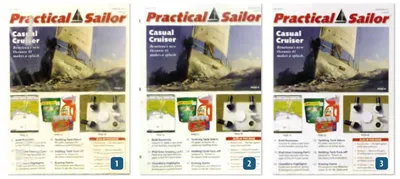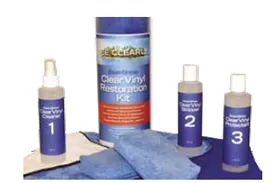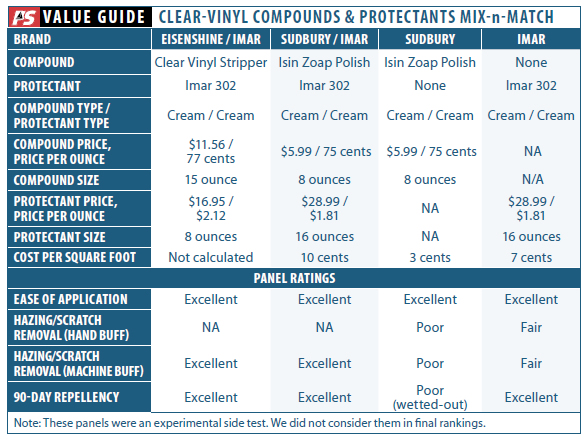
Photos by Drew Frye
Clear vinyl dodger windows, through which we keep watch, are annoying tattle tales, recording and announcing every bit of rough handling and neglect. They burn in the sun. They bleed plasticizers, turning yellow and sticky. And unlike mildew in the cockpit or an upholstery stain, we can’t simply ignore their flaws by turning our heads.
Premium clear-vinyl products-OSea and Strataglass-have polyurethane coatings to reduce scratching. Vinyls such as Regalite and Crystal Clear 20/20 are uncoated, but they are somewhat scuff resistant. Anything sharp or gritty will cut right through their finish; even fabric tiedowns and polished stainless can chafe them. In time, any clear-vinyl window that sees traffic nearby, is flogged with flapping sheets, or is rolled up and secured with fabric straps, will accumulate micro scratches, scuffs, and a gouge here and there.
Yellowing, stiffening, cracking, and a sticky film of plasticizer also come with time-more so if the windows are not covered or treated with protectants and cleaners (PS, January 2014). Visibility gradually decreases, and this general deterioration does more to shorten the usable life of the window than do scratches.
Is there anything boat owners can do to turn back the clock, to get a few more years of service from weathered clear-vinyl windows, and to slow the damage? While prevention through protection is the best solution, we set out to find compounding and polishing products that can help resurrect weathered vinyl. This article offers an introduction to the test, including a look at the products application and early results. How well the restored windows hold up compared to new or unrestored windows will be included in future test updates.
What We Tested
In the January 2014 issue, we reviewed clear-vinyl protectants and cleaners. For this evaluation, we focused on two-step products claiming to restore weathered vinyls clarity and to remove fine scratches and yellowing. The product systems include a fine abrasive compound and a protectant/polish.
Some vinyl makers, like Strataglass, require certain products (Imar) be used during the warranty period, otherwise the warranty can be voided. If you have a new dodger or windows, and the vinyl is still under warranty, we recommend using Imars cleaning and protecting products, which did well in our recent test.
This test field applies to those more seasoned clear-vinyl windows that are no long under warranty. The products should be used when conventional cleaners and protectants no longer get the windows clean and replacement is being considered.
The test field comprised one spray and 12 cream products from Star brite, Camco, Novus, EisenShine, Meguiars, and Sudbury. We tested each brands compound with its matching protectant, and we also ran some side tests with a few of the compounds using our favorite protectant from the January 2014 review: Imars Strataglass Protective Polish No. 302. Imar does not market a compounding product.
How We Tested
Because compounding makes the surface more porous, and thus more susceptible to environmental damage, we do not recommend restoration compounds for windows less than five to seven years old. As a result, we decided to use old dodger material for our scratch-removal testing.
We spent a year visiting canvas shops, digging through discards, looking for those with large windows that were evenly weathered and scratched. We also took a control panel from each dodger and used only the sections with equivalent deterioration. While time consuming, this brought us the level of uniformity we wanted. The samples varied in vinyl material quality and the extent of deterioration, but all the test samples were 40 mil.
We applied the vinyl compounds and protectants to 8- by 10-inch sections of the weathered vinyl and then mounted the panels on exposure racks-alongside our test panels from the vinyl cleaners and protectants evaluation (PS, January 2014).
With each product pair, we compounded one vinyl section by hand and another more vigorously with a rotatory buffer; testers finished each with the recommended protectant. The hand-buffed sections tested each systems light-buffing ability to remove haze, plasticizer bleed, and grime, while the machine buffing tested their ability to remove fine scratches and fogging. All of the test products were super easy to apply by hand and by machine.
We tested the EisenShine Stripper (best scratch remover in this test) and Isin Zoap Polish with the Imar 302 protectant (Best Choice protectant in prior Practical Sailor testing) to see if a mix-and-match approach made sense. (These turned out to be our very best panels.) We continue to believe Imar makes the best protectant.
After application, testers compared how well each system improved clarity and removed fine scratches. To quantify clarity improvement, testers counted the number of layers of restored product required to give the clarity equivalent of a single control panel. For example, those requiring three layers were rated Good; those requiring four layers were rated Excellent. We did not penalize compounds for not being able to remove gouges or other defects (epoxy and paint spatter) that would be unrealistic for a compound to remove.
After six weeks, testers conducted a water-beading test on the panels and recorded our observations. The test was repeated at the 90-day mark.
Armada
Armada 210 Plus is a white, cream compound that was very effective on small scratches. The Armada 210 protectant, the only aerosol product tested, was easy to polish and very fast to use. There is no required drying time; just spray and polish.
Several of the canvas shops we contacted strongly recommend the Armada restoration products.
Bottom line: At $11.56 for 15 ounces, Armada 210 Plus is a good value and a good performer; it is Recommended. The Armada 210 spray was the easiest to use, but the jury is still out on its longevity.

EisenShine
A three-part system, EisenShine was developed for the companys mobile detailing business, but the system is now available to the public. The first step, the Clear Vinyl Cleaner, is brand-new to the market, so it was not included in this round of testing.
The fine-grit Clear Vinyl Stripper was the most effective compound of the test group, easily removing heavy accumulations of grime with modest effort, and it was aggressive enough to remove moderate scuffing and fine scratches, given time and some patience; yet it was safe to use for the whole panel. The Clear Vinyl Protectant is effective at restoring gloss and providing extended water beading.
We also tested the EisenShine Stripper compound using the Imar 302 protectant as the sealing step, and this yielded our very best results.
The EisenShine system is sold as a kit-$60 for a 6-ounce bottle of each product, a buffing applicator, and some polishing cloths-which makes it difficult to directly compare its cost to other test products/systems.
Bottom line: The EisenShine products offered superior results. They are the Best Choice in this test field.
Meguiars Mirror Glaze 10/17
Developed for automotive maintenance, Meguiars Mirror Glaze 17, a mild abrasive compound, was the least effective of the group for hand polishing. It performed better when machine buffed, but it still failed to remove scratches as well as some other test products.
Meguiars Mirror Glaze 10 protectant cream, however, was very effective during tests.
Bottom line: There are better compounds than the Mirror Glaze 17, but testers liked the Mirror Glaze 10 sealer, and we Recommend it.
Novus
On the advice of the Novus manufacturer and other industry experts, we did not use the three-part systems coarse-grit product in our vinyl testing. We did try it on a few small scuffs and it left a dull spot, which is likely to weather more quickly. It is too aggressive for vinyl.
The Novus fine-grit Fine Scratch Remover compound and the Clean and Polish protectant, however, both performed well on our test panels.
Bottom line: Reasonably priced, the Novus Fine Scratch Remover ($1.10 per ounce) and the Clean and Polish ($1.11 per ounce) are both Recommended at this stage in the test.
Star brite
A fine abrasive cream, the Star brite Clear Step 1 was comparatively slow to polish by hand, but when worked a little longer with a buffer, it was very effective. We found the small, $1.94-per-ounce bottles (8 ounces) to be fairly expensive for large jobs.
The Clear Step 2 is a very effective protectant cream, a close second to Imar, so we have been testing it on new vinyl as well. It contains small amounts of siloxanes, the same ingredient found in Imars polish. It runs on the pricey side at $2.12 per ounce.
Bottom line: Both of Star brites products were on the expensive side, but both also were effective performers, so far earning our Recommendation.
Sudbury
Similar to the EisenShine, the two-part Sudbury Isin Zoap system was impressive in its ability to remove fine scratches without leaving swirls. The compound cream went further than most other products, polishing rapidly with minimum splatter.
The Isin Zoap Plus Cleaner Polish is a thin, fast-to-polish product, much like Armada 210, and a little goes a long way. However, we were not impressed with its anti-static properties. Isin Zoap Plus Cleaner and Polish was easy to use, but we are waiting to see how it does over time.
Pairing the Isin Zoap compound with the Imar 302 protectant gave excellent results.
Bottom line: The Sudbury Isin Zoap Polish is our Budget Buy, hands down. It offers Excellent performance and a good price for a product that goes far.
Imar
While not a scratch remover, the Imar 302 Strataglass Protective Polish can be very effective in removing imbedded dirt and limited surface oxidation, if used vigorously in the manner of a scratch-removing compound. Testers found that it was not as effective as abrasive-containing compounds at removing scuffs, but it does not remove surface coatings, so you wont accidentally make things worse. Also the surface will not be made micro-porous.
A cream-type cleaner wax, the 302 is the only polish endorsed by Strataglass makers for use during the warranty period. In tests, it easily produced a mirror gloss and was the most effective protectant for restoring gloss to vinyl. Imar does not offer a compound.
Bottom line: Imar 302 is expensive-$1.81 per ounce-but it offers the best protection, in our opinion. It remains our overall favorite vinyl protectant. Unfortunately, there is no brand-matched compound.

Conclusion
All of the test products dramatically improved the clarity of weathered vinyl test panels, typically improving clarity by two to four times. None removed yellowing, other than a small amount related to surface grime.
At this early stage of the testing, weve tapped several Recommended products and Best Choice compound and protectants. The long-term test will whittle down our top-pick list once we can better gauge durability and longevity.
For application by hand, the EisenShine Stripper compound was significantly more effective at removing fine scratches than other fine-grit products. The Imar Protective Polish, with no compound, did surprisingly well when applied with vigor but not as well as abrasives.
When machine buffed, the difference between compounds was far less dramatic. All produced satisfying results, but EisenShine remained the top performer by a slight margin.
All of the sealing protectants were easy to apply, gave a good shine, and provided a smooth water-beading surface. In the side tests, the Imar offered the smoothest feel, and after six months, it showed the best apparent durability. Among the polishes, the Eisenshine and Star brite followed closely.
We will continue this testing for at least three years. We are testing all of the protectants on both new vinyl (coated and uncoated) and restored used panels, and will be reporting back.
Early evidence suggests that polishing with abrasives increases the vulnerability of the vinyl to high-humidity fogging and atmospheric attack, and so increased diligence with protective products is warranted. For now, we suggest a practical routine for the typical weekend/seasonal sailor: Use a cleaner/protectant in-season, when a boat is sailed and the windows are cleaned every few weeks, followed by protectant cream in the spring, mid-season, and fall.





































